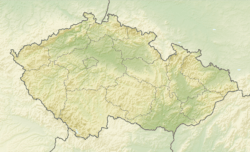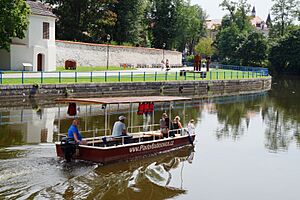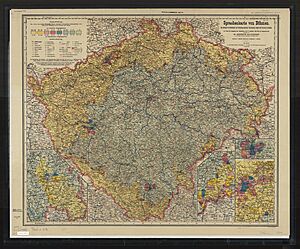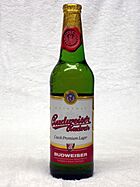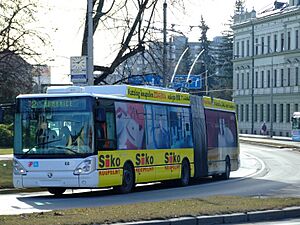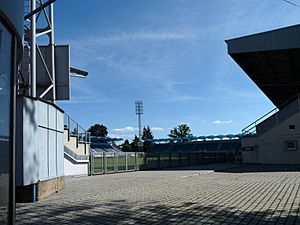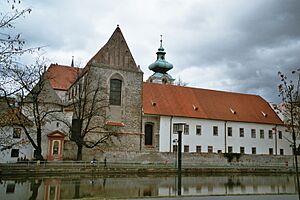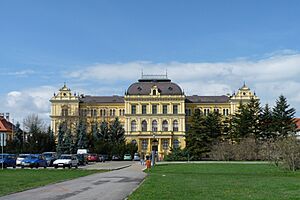České Budějovice facts for kids
Quick facts for kids
České Budějovice
Budweis
|
|||||
|---|---|---|---|---|---|
|
Statutory city
|
|||||
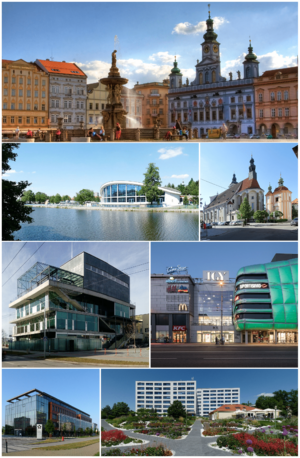
From top: Ottokar II Square, city swimming stadium, Cathedral of St. Nicholas, Máj centre, IGY shopping centre, Faculty of Arts of the University of South Bohemia, regional hospital
|
|||||
|
|||||
| Country | |||||
| Region | South Bohemian | ||||
| District | České Budějovice | ||||
| First mentioned | 1251 | ||||
| Area | |||||
| • Total | 55.71 km2 (21.51 sq mi) | ||||
| Elevation | 381 m (1,250 ft) | ||||
| Population
(2024-01-01)
|
|||||
| • Total | 97,377 | ||||
| • Density | 1,747.93/km2 (4,527.1/sq mi) | ||||
| Time zone | UTC+1 (CET) | ||||
| • Summer (DST) | UTC+2 (CEST) | ||||
| Postal code |
370 01
|
||||
České Budějovice is a city in the South Bohemian Region of the Czech Republic. It has about 97,000 people living there. The city is in the valley of the Vltava River, where it meets the Malše River.
České Budějovice is the biggest city in its region. It is an important center for politics and business. It is also home to the Roman Catholic Diocese of České Budějovice and the University of South Bohemia. The city is very famous for its Budweiser Budvar Brewery. The old part of the city is very well kept and is a special protected area.
Contents
About the City's Name
The name Budějovice comes from an old Slavic name, Budivoj. It means "the village of Budivoj's people." The name changed over time.
When the city was officially founded in 1265, it was called Budwoyz, which later became Budweis in German. The Latin name was Budvicium.
After the Hussite revolution in the 1400s, the name České Budějovice was used. This means "Bohemian Budějovice," to tell it apart from Moravské Budějovice ("Moravian Budějovice").
Where is České Budějovice?
České Budějovice is about 120 kilometers (75 miles) south of Prague. It sits in a flat area called the České Budějovice Basin. Most of the city is flat, but the eastern parts have some hills.
The city is located in the valley of the Vltava River, where it joins the Malše River. There are also many large fish ponds in the northwest part of the city. The biggest one is Novohaklovský Pond. Some of these ponds are part of a nature reserve called Vrbenské rybníky.
The weather in České Budějovice is a cooler and wet type of humid continental climate. This means it has four seasons. Winters are often cloudy and dry. Spring is sunny and wetter. Summer is rainy and warm. Autumn is dry.
A Look Back in Time
Early Days and Growth (1200s–1700s)
The first time Budějovice was written about was in 1251, when it was just a village. In 1265, King Ottokar II officially founded the royal city. A knight named Hirzo planned the city. It had strong walls and three gates.
The city quickly became important for politics and business in southern Bohemia. It grew rich from trade and crafts, and from silver mining nearby. Many German-speaking people moved here from other areas.
In 1341, King John of Bohemia allowed Jewish families to live inside the city walls. The first synagogue was built in 1380. However, in 1505–1506, Jewish people were asked to leave the city.
In the 16th century, more German craftspeople came. By the 18th century, Germans made up most of the population. The city's walls helped it survive attacks during the Hussite Wars. But a big fire in 1641 destroyed two-thirds of the city. After the fire, the city was rebuilt in the beautiful Baroque style. In 1785, the Church of Saint Nicholas became a cathedral.
Modern Times (1800s–1900s)
In the 1800s, České Budějovice became an industrial city. It was a big center for trade. The Budweis–Linz Horse-Drawn Railway was built between 1825 and 1832. This was one of the oldest public railways in Europe.
The famous Koh-i-Noor Hardtmuth pencil company moved its production here in 1847. In 1895, the Český akciový pivovar (which later became Budweiser Budvar Brewery) was founded.
From 1848 until World War II, a Jewish community lived here again. By 1925, there were over 1,400 Jewish people. The city was mostly German-speaking until 1880. After that, Czechs became the majority.
During World War II, from 1939 to 1945, the city was part of the Protectorate of Bohemia and Moravia. České Budějovice was damaged by air raids in March 1945. At the end of the war, in May 1945, Soviet troops entered the city. Most of the German population, about 6,000 people, then left the city.
Population Changes
| Historical population | ||||||||||||||||||||||||||||||||||||||||||||||||||||||||
|---|---|---|---|---|---|---|---|---|---|---|---|---|---|---|---|---|---|---|---|---|---|---|---|---|---|---|---|---|---|---|---|---|---|---|---|---|---|---|---|---|---|---|---|---|---|---|---|---|---|---|---|---|---|---|---|---|
|
|
|
||||||||||||||||||||||||||||||||||||||||||||||||||||||
| Source: Censuses | ||||||||||||||||||||||||||||||||||||||||||||||||||||||||
City's Economy
České Budějovice is the main economic hub for the whole South Bohemian Region. Many big companies have their main offices here. Some of the largest employers in the city include:
| Company | Number of employees | What they do |
|---|---|---|
| České Budějovice Hospital | 4,000–4,999 | Health care |
| dm-drogerie markt | 3,000–3,999 | Shops |
| Robert Bosch | 3,000–3,999 | Car parts |
| University of South Bohemia in České Budějovice | 2,000–2,499 | Education |
| ČEVAK | 1,000–1,499 | Water services |
| E.ON Česká republika | 1,000–1,499 | Electricity and gas |
| Jednota | 1,000–1,499 | Shops |
| Groz-Beckert Czech | 1,000–1,499 | Tools for textiles |
| Madeta | 1,000–1,499 | Dairy products |
| Swietelsky stavební | 1,000–1,499 | Construction |
Famous Beer
Budějovice has been known for its beer since the 1200s. For a time, it was the official brewery for the Holy Roman Emperor. Budweiser Bier (beer from Budweis) became very famous, like Pilsner beer from Plzeň. Brewing is still a very important industry here.
The largest brewery, started in 1895, is Budweiser Budvar. This brewery has the right to sell its beer as "Budweiser" in much of Europe. In other places, it's sold as "Budvar" or "Czechvar." This is because of legal disagreements with another company, Anheuser-Busch, which sells its beer as "Bud" in most of Europe. The American "Budweiser" beer was first made to be like the famous Czech beer.
The oldest brewery still working was founded in 1795. It is now called "Pivovar Samson." It used to be called "Budweiser Bürgerbräu" in German. This brewery also sells its beer around the world, often as "Samson" or "Crystal."
Getting Around
A major road, the European route E55, goes through České Budějovice. This road connects Prague to the Czech-Austrian border. The D3 motorway is part of this route. Another important road is the I/20, which links České Budějovice to Plzeň and Karlovy Vary.
There are also direct international train lines that pass through České Budějovice. These lines connect cities like Vienna, Prague, and Linz. The city has four train stations, with the main one being České Budějovice.
The České Budějovice Airport is about 6 kilometers (4 miles) southwest of the city. It handles flights within the country and to other countries.
Inside the city, you can get around using buses and trolleybuses. The city owns the company that runs this public transport.
Culture and Events
A very important event each year is the Země Živitelka ('Earth the Breadwinner') exhibition. It focuses on farming and the food industry. It takes place at the Výstaviště České Budějovice, which is a large area for events. This exhibition has been held every year since 1973.
In 2028, České Budějovice will be the European Capital of Culture. This is a special title given to cities that celebrate their culture.
Sports in the City
České Budějovice has many sports places and stadiums. These include the football Stadion Střelecký ostrov, the ice-hockey Budvar Arena, and the Athletic Stadium Sokol.
The Swimming Stadium České Budějovice has a large indoor pool, a diving pool, saunas, and outdoor pools. It also has a covered water slide and a new whirlpool.
Sports Teams
- SK Dynamo České Budějovice (football)
- Motor České Budějovice (ice hockey)
- Jihostroj České Budějovice (volleyball)
- TJ Sokol České Budějovice (athletics)
- Hellboys České Budějovice (american football)
- RC České Budějovice (rugby football)
- TJ Lokomotiva České Budějovice (handball)
- Budějovické Barakudy (cricket)
- FBC Štíři České Budějovice (floorball)
- TJ Dynamo České Budějovice (football tennis)
- SKVS České Budějovice (canoe slalom)
Places to See
The old city center is very well preserved. It is a special protected area because of its history.
One of the main sights is the Black Tower (Černá věž). It was built between 1550 and 1577 to be a guard tower and a bell tower. It is 72 meters (236 feet) tall, and you can climb 225 wooden steps to the top. The tower has six bells.
The Iron Maiden Tower and the Rabenštejn Tower are old prisons from the 1300s. They are some of the few parts left of the old city's Gothic walls.
City Square
The historic city center is built around the large Přemysla Otakara II Square. This square is shaped like a perfect square and is one of the biggest in the country. It is surrounded by beautiful Renaissance and Baroque houses with arcades (covered walkways). Many of these houses have older Gothic parts inside.
In the middle of the square is the Samson Fountain. This Baroque fountain was built between 1721 and 1727. It is the largest fountain in the Czech Republic, with a diameter of 17 meters (56 feet). It was not just for decoration; it also brought water to the city from the Vltava River. Near the fountain is the "Lost Rock," which is a small piece of the original old pavement.
The City Hall is the most striking building on the square. It was first a Renaissance house from the mid-1500s. It was completely rebuilt in the Baroque style between 1727 and 1730. Its front has three towers and four statues. The tallest tower has a carillon (a set of bells) from 1995. The City Hall is still used today, and you can take guided tours there.
Churches and Monasteries
The Dominican monastery and its Church of the Presentation of the Blessed Virgin Mary are the oldest historical buildings in the city center. The monastery was founded in 1265, at the same time as the city. The buildings were originally Gothic but were later rebuilt in the Baroque style.
The former Capuchin monastery was founded in 1614. The Church of Saint Anne was built in the early Baroque style between 1615 and 1621. This monastery was closed in 1804. In the 1980s, the church was changed into a concert hall.
The Church of Saint Nicholas is a large church near the main city square. It was founded in 1265. After a big fire in 1641, it was rebuilt in the Renaissance style. In 1785, it became a cathedral.
The Church of the Holy Family was built in the neo-Gothic style between 1886 and 1887. It has beautiful decorations inside.
The Church of Saints John the Baptist and Procopius was founded in the early 1200s, in the original village before the city was built. It has been changed many times over the years. Next to the church is the oldest cemetery in České Budějovice, with many old and interesting tombstones.
Museums to Visit
The Museum of South Bohemia was started in 1870. It opened to the public in 1877. The current museum building was built in the Neo-Renaissance style between 1899 and 1901 and opened in 1903. The museum has exhibits on archaeology, nature, geology, and local culture.
The Museum of the Horse Drawn Railway is part of the Museum of South Bohemia. It is located in an old guardhouse where the Budweis–Linz Horse-Drawn Railway began. This building and parts of the old railway are protected as national cultural monuments.
In Books
The city is an important place in the novel The Good Soldier Švejk by Jaroslav Hašek. České Budějovice was also the setting and the first title for the play The Misunderstanding by Albert Camus.
Famous People from České Budějovice
- Adalbert Gyrowetz (1763–1850), composer
- Franz Schuselka (1811–1886), politician
- Otto Pilny (1866–1936), painter
- Otto Steinhäusl (1879–1940), police officer
- Jan Palouš (1888–1971), ice hockey player
- Rudolf Tomaschek (1895–1966), experimental physicist
- Anna Binder-Urbanová (1912–2004), philosophy lecturer
- Norbert Frýd (1913–1976), writer
- Rolf Thiele (1918–1994), film director and producer
- Haro Senft (1928–2016), film director
- Marta Kubišová (born 1942), singer
- Vladimír Remek (born 1948), cosmonaut, pilot and politician
- Pavel Tobiáš (born 1955), football player and manager
- František Straka (born 1958), football player and manager
- Zdeněk Tůma (born 1960), economist
- Karel Roden (born 1962), actor
- Karel Havlíček (born 1969), politician
- Karel Vácha (born 1970), footballer
- Jiří Lerch (born 1971), footballer
- Jaroslav Modrý (born 1971), ice hockey player
- Radek Mynář (born 1974), footballer
- Stanislav Neckář (born 1975), ice hockey player
- Václav Prospal (born 1975), ice hockey player
- Martin Hofmann (born 1978), actor
- Roman Lengyel (born 1978), footballer
- Vladimíra Uhlířová (born 1978), tennis player
- Josef Melichar (born 1979), ice hockey player
- David Lafata (born 1981), footballer
- Václav Nedorost (born 1982), ice hockey player
- Filip Novák (born 1982), ice hockey player
- Jiří Kladrubský (born 1985), footballer
- Milan Gulaš (born 1985), ice hockey player
- Tomáš Mertl (born 1986), ice hockey player
- Martin Hanzal (born 1987), ice hockey player
Sister Cities
České Budějovice is connected with these cities:
Images for kids
See also
 In Spanish: České Budějovice para niños
In Spanish: České Budějovice para niños





